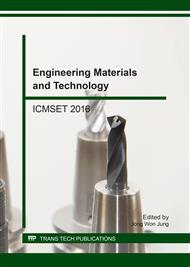p.70
p.77
p.83
p.90
p.95
p.101
p.107
p.114
p.119
Evaluation of Surface Quality and Signal Characteristics in Milling Process of Al7075-T651
Abstract:
Recently, as the automotive and aerospace industry research has focused one weight lightening, the use of functional aluminum alloys has been increasing. Aluminum alloys are effective materials because of their high specific strength and high stiffness ratio. However, machining deformation and heat deflection can occur depending on the machining type. Owing to these difficult-to-cut characteristics, it is necessary to monitor the machined surface quality of aluminum alloys. In this paper, we study the correlation between surface quality, namely burr formation and surface roughness, related to cutting parameters and signals obtained from multiple sensors. The output signals are measured by an acoustic emission (AE) sensor and an accelerometer and are analyzed in the signal frequency domain. By using the wavelet transform of analyzed signals, we determine the correlation between surface quality and signals. Based on this investigation, a surface quality monitoring system can be suggested.
Info:
Periodical:
Pages:
95-100
Citation:
Online since:
June 2017
Authors:
Keywords:
Price:
Сopyright:
© 2017 Trans Tech Publications Ltd. All Rights Reserved
Share:
Citation:


